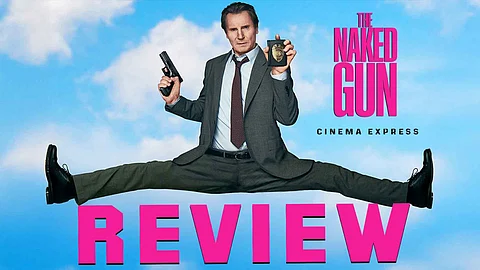The Naked Gun Movie Review: Liam Neeson excels in his comedy debut but repetition lets him down
The Naked Gun(2 / 5)
The Naked Gun Movie Review:
The Naked Gun franchise draws its humour from a barrage of visual gags, slapstick humour, and non-sequiturs. There is so much going on in the background or foreground in virtually every scene in the franchise that it is easy to miss a vile joke here, a playful gag there. Each of the shenanigans from the lead characters deserves your full attention. However, the strength of the franchise lies in the spot-on casting, most notably Leslie Nielsen as Police Squad Detective Frank Drebin in the original trilogy. When it comes to The Naked Gun (2025), the latest instalment in the franchise, the biggest strength is the presence of Liam Neeson as Frank Drebin Jr. The Naked Gun marks Neeson’s first role in a full-length comedy, but the actor excels in everything, from delivering the deadpan expressions to doing drag. He does it all with a commendable commitment to his craft and a childlike enthusiasm that makes Frank Drebin Jr an easily likeable character. However, the film struggles to establish a reason for its existence within the larger franchise. The makers describe it as a legacy sequel, but all it has is one visual gag to cement the ‘legacy’ aspect. This becomes an issue because the comedy mostly follows the pattern of the original trilogy, with very little freshness to it.
Much like in the first film of the franchise, the plot (if you can call it that) follows Drebin as he investigates the possible murder of a man named Davenport. Pamela Anderson’s Beth Davenport asks Drebin to look into the matter and find out her brother’s killer. The Naked Gun is a parody of police procedurals, which predate the 1988 original. Therefore, do not expect any serious investigation here. The biggest joke stems from the fact that Drebin makes a mess of the case, despite getting easy clues that would lead him to the perpetrator, and that he inadvertently solves it. Everything in the film is up for the taking in the gags and slapstick humour department, and while many of them do land, the film loses steam towards the end and suffers from an identity crisis.
Director: Akiva Schaffer
Cast: Liam Neeson, Pamela Anderson, Danny Huston, Paul Walter Hauser
Danny Huston plays Richard Cane, a comical and deliberately over-the-top version of the sort of James Bond film-style villain, which he has pulled off to a great effect. However, the film rehashes the 1988 original’s idea of the villain using mind control to create utter chaos among the masses. At least, in an AI-driven world where technology has become way more sophisticated than before, the makers could have changed the device that the film uses to tell its ‘story’. Perhaps, they are aware of this potential weakness themselves, as the gadget that Cane uses to execute his evildoings itself is named ‘P.L.O.T. Device’.
The factor that almost makes you overlook all these flaws at least for a while, is Neeson as Drebin Jr. The actor is in fine form here and strikes up a cracking chemistry with Anderson. They are a hoot and complement each other very well. The scene where Anderson’s Beth Davenport cleans Drebin’s microwave oven with a stick, as Kevin Durand’s character looks at them through binoculars, is sure to crack up the audience. It goes a level above the original trilogy in terms of the sexual innuendos at play. A more hilarious moment involves Drebin merely beating up a side character in the background even as Beth Davenport tries to have a serious conversation with Cane to distract him. It is the kind of visual non-sequitur that makes the franchise distinctive from other similar films.
A gag that parodies the serious, coffee-addicted cop stereotype also lands when you least expect it. Further, an owl reference at the start of the film hints at the kind of visual gag it is set to unleash later on, and it does not disappoint when the bird becomes a physical manifestation of Drebin’s subconscious mind. Unfortunately, though, the film does not have enough of such comedy to make it differ a bit more from the trilogy that precedes it.


